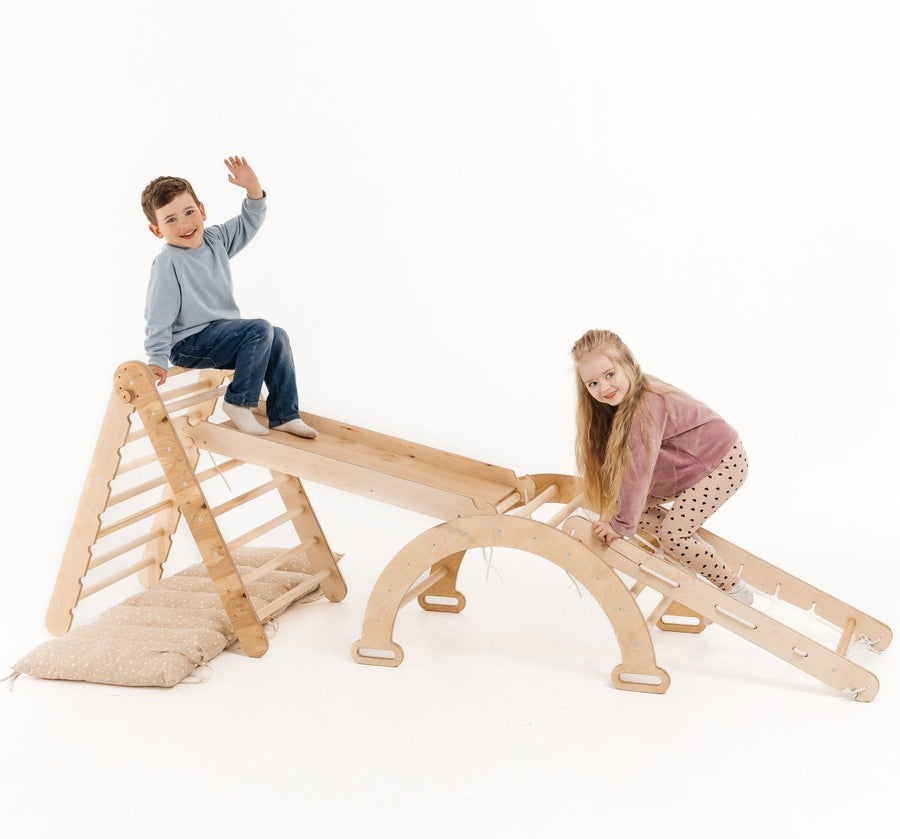Unlocking Boundless Potential: The Impact of the Pikler Triangle on Motor Skill Development
Introduction: Journey Through Motor Skill Development
In this article, we will delve into the fascinating world of motor skills - the essential building blocks that shape our ability to navigate and interact with our surroundings.
Moving beyond the theoretical understanding, we will explore the practical application of these motor skills in our everyday lives, unveiling how they subtly weave into our routines and help us perform complex tasks with incredible precision.
Advancing into early childhood development, we will share concise tips on bolstering both gross and fine motor skills in toddlers.
Ultimately, we will spotlight the Pikler Triangle, a multifunctional tool renowned for developing and enhancing motor skills.
We hope this comprehensive guide provides you with both knowledge and inspiration, making the often complex topic of motor development more accessible and engaging!
What are motor skills?
Motor skills serve as the essential foundation that helps children explore and interact with their world. These skills fall under two primary categories: gross motor skills and fine motor skills. Each plays a unique role in a child's growth, but both are critical for their overall development.

Source: Circlecare4kids.com
Gross motor skills
Gross motor skills involve larger muscle groups and are responsible for our ability to make significant, often whole-body movements. These skills are largely controlled by the cerebellum, a region of the brain located at the back of the skull. This region coordinates voluntary movements, balance, and muscle coordination.
Fine motor skills
On the other hand, fine motor skills involve more precise, intricate movements and use smaller muscle groups, especially in the hands and fingers. Fine motor skills require a high level of coordination between the brain and muscles, with key roles played by the motor cortex (the part of the brain controlling voluntary movements) and the basal ganglia (responsible for the planning of motor movements).
In essence, motor skills act as the bridge between our physical bodies and the external world. They are an expression of our neurological functioning, enabling us to interact with our surroundings. Both gross and fine motor skills are fundamental to a child's growth and understanding of their own capabilities.
How do people use motor skills in everyday life?
Motor skills are like an invisible thread, subtly yet crucially woven into the fabric of our daily lives. Every action, from the moment we wake up in the morning to when we go to bed at night, involves the use of these skills in some form.
Journey of Movement: The Role of Gross Motor Skills
When we get out of bed, walk into the kitchen to make breakfast, or jog in the park, we are using our gross motor skills. These skills enable us to navigate the world around us, maintaining balance and coordination. Even activities that seem passive, like standing in line at the supermarket or sitting upright at the dining table, are supported by gross motor skills. They keep us steady, aid in postural control, and allow us to move confidently within our environment.

Source: Runnersworld.com
Small Movements, Big Impact: Deciphering Fine Motor Skills
When we button a shirt, type on a keyboard, use a fork, or even swipe on our smartphones, we are using fine motor skills. These skills enable us to interact with objects in a controlled and refined manner.
Both these skills constantly work together, like a well-rehearsed symphony, enabling us to perform complex tasks. Imagine baking a cake - you use gross motor skills to gather the ingredients, mix the batter, and put the pan in the oven. But when measuring the ingredients or decorating the cake, you'll need fine motor skills for precision.
In essence, motor skills are our silent partners, tirelessly facilitating our interaction with the world around us. They are a demonstration of the remarkable coordination capabilities of the human body and mind.
How to develop motor skills in toddlers?
Moving forward, developing motor skills in toddlers can feel like an adventurous journey, filled with rewarding milestones. There's an array of playful and engaging activities that can help nurture these skills while ensuring that your little ones are having fun.
Little Adventurer: Enhancing Gross Motor Competence in the Early Years
Gross motor skills help your little ones to sit upright, roll over, or take those exciting first steps. To promote these skills, encourage activities that get the whole body moving. Play sessions in the park or even a simple game of catch can be great starters.
The Art of Little Things: Cultivating Fine Motor Skills in Toddlers
Fine motor skills are what allow your child to give you a high five or make their first scribbles with a crayon. To develop these skills, activities that involve careful manipulation of objects can be beneficial. Simple home-based tasks like stacking blocks, stringing large beads, or manipulating playdough can do wonders. These tasks not only keep your child engaged but also provide them with the opportunity to use their fingers and hands, thereby refining their dexterity and hand-eye coordination.

Source: Istockphoto.com
Incorporating these activities into their daily routine can be helpful. However, it's important to remember that each child is unique, and they develop at their own pace. So instead of focusing solely on achieving specific milestones, the goal should be to create a stimulating environment where your child feels free to explore and engage.
10 Ways to improve motor skills and coordination of movements
Continuing the idea of fostering motor skills and coordination, guiding children on this path is indeed an exciting journey that is as fun as it is rewarding. To facilitate this, here are ten creative ways you can encourage this development:
- Yoga Adventures: Introducing your child to child-friendly yoga can be a delightful way to boost their gross motor skills and coordination. Yoga poses help strengthen their muscles, improve balance, and enhance body awareness.
- Scavenger Hunts: Plan scavenger hunts that require your child to search for hidden objects around the house or garden, providing opportunities for tactile stimulations and fine motor skill development. You can also add a twist by using a treasure map or clues to make it even more exciting.
- Balancing Acts: Balancing activities are excellent for developing core strength and stability. Provide your child with climbing toys to challenge their balance and body coordination.
- Arts and Crafts Galore: Engage your child in arts and crafts projects that require cutting, colouring, and glueing. This not only encourages creativity but also strengthens hand and finger muscles.
- Dance Party Time: Dance to your child's favourite music together and encourage them to mimic your movements. Dancing is a fantastic way to improve gross motor skills, rhythm, and body awareness. It also provides an excellent opportunity for bonding and laughter!
- Playing with Sand and Water: These sensory activities offer numerous opportunities for pouring, digging, and scooping, which aid in refining fine motor skills.
- Sorting Games: Sorting toys by size, colour, or shape is a great activity for developing hand-eye coordination.
- Cooking Together: Simple tasks like stirring, pouring, or kneading can be fun and beneficial for their fine motor skills.
- Fine Motor Puzzles: Invest in a variety of age-appropriate puzzles that challenge your child's fine motor skills and problem-solving abilities. From wooden peg puzzles to interlocking jigsaw puzzles, these activities offer a delightful way to learn and grow.
- Musical Statues: Dancing and freezing to music helps children practise gross motor skills and body control. The sudden stops and starts during freezing moments improve their ability to control and transition between movements.

Source: Istockphoto.com
However, the secret ingredient in this journey of motor skills development is your love and support. Celebrate their achievements, no matter how small, and encourage their efforts. Your enthusiasm and pride in their progress will not only motivate them but also strengthen the bond between you. This journey of motor skill development is not just about growing up, it's about growing together, cherishing each magical moment along the way.
The role of the Pikler Triangle in the Montessori environment to improve motor skills and coordination
Climb, slide, and explore: the ultimate 4-in-1 Montessori climbing frame experience
The Pikler triangle, a pivotal component of this Montessori climbing set, plays a significant role in a child's motor development. It offers a complex climbing challenge for children, sparking their natural curiosity and inspiring a love for physical activity. This pyramid-like climbing ladder enhances gross motor skills, muscle strength, and balance, enabling kids to learn and understand their body's capabilities and limitations. Its double-sided design provides an ample usable area, making it a versatile platform for shared play and exploration.
Complementing the pikler, the climbing arch provides different layers of engagement. For toddlers, it serves as a support while learning to stand, bolstering their confidence, while a single flip transforms into a cosy rocker - simply throw in a cushion for comfort or cover with a blanket for a full-fledged fort! As the child grows, the arch evolves into an advanced climbing structure or a balance board when flipped, continually challenging and developing the child's equilibrium and dexterity.
The accompanying climbing net and slide further enhance the play environment. The climbing net, made from durable materials, offers an additional level of complexity. Children can push, step, and climb, promoting a variety of motor skills and coordination. The dual-function slide presents a smooth sliding surface and a climbing ramp, offering different play opportunities. Positioned as a bridge between climbing structures, it fosters spatial reasoning and problem-solving.
In summary, the Pikler triangle, being a timeless classic, is the star player in this set, but its role is amplified by the collaboration with other components in the Montessori climbing set. Together, they create an engaging, multifunctional play environment that promotes key physical and cognitive development in children following the Montessori principles.

Source: Goodevas.com
Inspire active play: introducing the 2in1 Montessori climbing set with triangle ladder and slide Board
Yet again at the heart of this Montessori set lies the Pikler triangle, a transformative piece of equipment crucial for a child's motor skills progression. This deceptively simple structure serves as both an athletic challenge and a joyous plaything, catering uniquely to children at varying stages of coordination.
Designed to satisfy an innate thirst for movement, the Pikler fosters active engagement, allowing even two children to play at once. The five-position adaptability means the climbing difficulty grows with your child, encouraging constant progress and evolution of their physical abilities. This natural progression makes the Pikler an invaluable part of a child's growth, guiding their journey from initial toddling to confident climbing.
As mentioned previously, the slide further amplifies the strength and coordination lessons initiated by the Pikler. It allows to develop strength and flexibility: when climbing a slide, children use the muscles of the arms, legs and core, which contributes to the development of their strength and flexibility. Alongside the motor development, it can also be integrated into their imaginative role-playing scenarios. For instance, it can transform into a mountain they bravely climb or a slippery waterfall they joyfully descend. This imaginative play not only sparks creativity but also enriches problem-solving skills while ensuring a delightful, immersive experience.

Source: Goodevas.com
Final thoughts
Overall, the Pikler Triangle is an invaluable tool in fostering motor skill development in children. It serves as a conduit for a child's exploration of strength, balance, and agility. As a part of various Montessori climbing sets, it effectively integrates with components such as the slide and the climbing net, which further enrich the learning environment. These accessories offer diverse modes of play and imaginative scenarios, promoting creative thinking while keeping the play fun and engaging. Therefore, the Pikler triangle, encapsulating the core Montessori principles of self-guided learning, facilitates not just physical development but cognitive and imaginative growth too. It truly makes a pivotal impact on the multifaceted journey of a child's motor skill development, making it a worthwhile investment for any parent or educator.
References:
- Lillard, Angeline (2007) “Montessori: The science behind the genius”. Oxford University Press.
- Gabbard, Carl (2008) “Lifelong motor development”.
- Payne, Gregory and Isaacs, Larry (2002) “Human motor development: A lifespan approach”.
- Shonkoff, Jack and Phillips, Deborah (2000) “From neurons to neighborhoods: The science of early childhood development”. National Academy Press.






Dejar un comentario